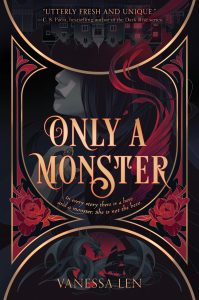Vanessa Len Guest Post–“Goosebumps and Paradigm Shifts”
Note: This piece includes spoilers for The Sixth Sense, After Earth, The Usual Suspects and A Game of Thrones.
I love far future science fiction and survival horror and, a few years ago, I saw a movie trailer that seemed like it could be my kind of thing—Will Smith and his son crash-land on a mystery planet and have to survive its CGI perils. As the planet’s strange and terrifying creatures flash up on screen, Will Smith says: “This is a Class 1 quarantined planet. The threats we will be facing are real. Everything on this planet has evolved to kill humans.” Then he asks his son a question: “Do you know where we are? This is Earth.”
At the word Earth, I felt goosebumps. I watched the trailer again, and at that Planet of the Apes plot twist, I felt it again.
As it turned out, the film, After Earth, wasn’t really for me, but the trailer—the shivery feeling—stuck with me. And as someone who loves plot twists, I watched it over and over trying to figure out the mechanics. What exactly about that moment had given me goosebumps? How had that plot twist been crafted? And why was I strangely reminded of the beacons of Gondor lighting up in Lord of the Rings? And, even more strangely, of watching clips of unexpected talent on The Voice and X-Factor and Idol auditions?
 If I broke down the structure, I could see how the After Earth trailer twist worked. The viewer was given information (a Class 1 quarantined planet) that created a set of assumptions (an unfamiliar place, maybe something like the Alien planet). Then new information was supplied that subverted those assumptions, changing something fundamental in the viewer’s understanding of the story (this is Earth). The viewer experiences a paradigm shift.
If I broke down the structure, I could see how the After Earth trailer twist worked. The viewer was given information (a Class 1 quarantined planet) that created a set of assumptions (an unfamiliar place, maybe something like the Alien planet). Then new information was supplied that subverted those assumptions, changing something fundamental in the viewer’s understanding of the story (this is Earth). The viewer experiences a paradigm shift.
A few years later, Karen Joy Fowler introduced me to Damon Knight’s term: revelation plot. Karen described it as a plot where the movement of the story takes place in the reader rather than on the page. The climax of the story is when the reader understands that they’re not reading the story that they thought they were reading. Bruce Willis is a ghost. Keyser Söze was in the room with us all along.
A paradigm-shifting twist doesn’t just surprise or shock us, it makes us re-evaluate our basic assumptions. And in a revelation plot, those assumptions are generally so changed that if we were to go back and read or watch the story again, we’d experience an entirely different narrative.
After Earth was co-written and directed by M. Night Shyamalan, who is known for his revelation-plot films, the most famous of which is The Sixth Sense.
The revelation in the Sixth Sense relies on the same technique seen in the After Earth trailer: initial information creates assumptions in the viewer’s mind, and then new information subverts those assumptions.
In the After Earth trailer, the paradigm shifting twist comes just after the two-minute mark. In contrast, The Sixth Sense is a feature-length film and the twist is at the end. To pull off that twist, Shyamalan has to craft two simultaneous and different feature-length narratives: an apparent narrative and a hidden one.
In the apparent narrative, Bruce Willis’s character is a psychologist helping a young boy experiencing poor mental health. In his home life, the psychologist is having marital problems. The viewer ‘knows’ this because, among other techniques of misdirection, the character himself gives us that narrative: “His wife doesn’t like the person he’s become. They don’t speak anymore. They’re like strangers.” The naïve viewer sees the psychologist having sad, one-sided conversations with his wife, and ‘knows’ why. They experience the apparent narrative.
 At the end of the film, Shyamalan supplies new information: Bruce Willis’s character has been dead all along. The viewer experiences a paradigm shift in understanding of all the previous scenes. Now they know that the young boy hasn’t been unwell – he really could see dead people; and the conversations between husband and wife weren’t one-sided because of a relationship breakdown, but because one of the participants was dead. They realize that they haven’t been watching the story that they thought they were watching. The twist works because the two simultaneous narratives—the apparent and the hidden—are coherent and complete. The film makes sense to both naïve and knowing viewers.
At the end of the film, Shyamalan supplies new information: Bruce Willis’s character has been dead all along. The viewer experiences a paradigm shift in understanding of all the previous scenes. Now they know that the young boy hasn’t been unwell – he really could see dead people; and the conversations between husband and wife weren’t one-sided because of a relationship breakdown, but because one of the participants was dead. They realize that they haven’t been watching the story that they thought they were watching. The twist works because the two simultaneous narratives—the apparent and the hidden—are coherent and complete. The film makes sense to both naïve and knowing viewers.
Returning to the After Earth trailer, to the moment Will Smith says ‘This is Earth’, I could see the mechanics behind the plot twist itself—the paradigm shift—but I still wasn’t sure why I’d felt chills.
Perhaps a clue can be found in people’s reactions to music. Several studies have found that certain pieces of music can evoke feelings of chills and goosebumps. Arjmand, Hohagen, Paton, and Rickard (2017) describe an early study by Sloboda that “asked participants to identify music passages which evoked strong, physical emotional responses in them, such as tears or chills.” That study found that: “The most frequent musical events coded within these passages were new or unexpected harmonies, or appoggiaturas (which delay an expected principal note).” Arjmand et al confirm this and similar research in their own findings, concluding that: “strong emotional responses often coincide with music events that signal change, novelty or violated expectations.”
We could think of these as musical ‘plot twists’ or paradigm shifts.
But still…. If it was the paradigm shift alone, shouldn’t I feel goosebumps at other types of paradigm shift?
In A Game of Thrones, George R. R. Martin crafts a paradigm-shifting twist with the death of Ned Stark. Martin isn’t writing a revelation plot like Shyamalan where everything prior to the twist can be re-experienced as a different narrative. Instead, Martin’s twist transforms the reader’s understanding of where the story could be headed.
Shyamalan often uses exposition to set up assumed narratives and twists, but in A Game of Thrones, Martin employs a different technique. He uses the reader’s familiarity with structure to craft assumptions.
In the story, the character of Ned Stark is given the milestones of the hero’s journey—one of the most popular and well-known structures in western fantasy. First, Ned is introduced to us in his ordinary world at Winterfell. Then he is given a call to adventure to become the Hand of the King. Then he crosses the threshold into King’s Landing, gaining allies and enemies, and he passes the first test of figuring out why his brother-in-law was killed.
Every fantasy fan knows what happens next in that structure: Ned is supposed to fail and succeed in a few more trials, and then advance deeper into the world of the book. He’s supposed to learn some truths, defeat the bad guy, save the world, and go home a changed man. But that doesn’t happen. After passing the first test, Ned fails the next one. He dies.
By putting Ned through the paces of the hero’s journey, Martin leads the reader to assume that Ned Stark will complete the hero’s journey and emerge victorious. When Martin subverts those assumptions, the reader has a shocking, paradigm-shifting new understanding about this world and this series. We realize that this is a world where heroes can lose. And where anyone can die.
I vividly remember my reaction to that scene: I was shocked—almost to the point of disbelief—but I didn’t experience goosebumps. So maybe it wasn’t the paradigm shift alone that had given me chills.
I thought again about the seemingly incongruous scenes that the After Earth clip had reminded me of: the beacons of Gondor and viral talent show auditions.
I investigated the beacons scene first…. I’ve noticed that I often feel a sense of awe when seeing or reading depictions of human connection combined with a sense of vast scale. I get that feeling, for example, in Peter Jackson’s Lord of the Rings adaptation when the beacons of Gondor light up across each peak of a mountain range, in a call for aid. Perhaps the After Earth trailer taps into a similar feeling by depicting Earth as a rediscovered home-world—combining a sense of human connection and a vast scale of time. Perhaps the evocation of awe is enhanced by the paradigm shift, causing the chills.
Next, viral talent show clips… One of the earliest was Susan Boyle’s 2009 Britain’s Got Talent audition. As I write this, the clip has more than 260 million views, and even now, many years later, there are numerous comments describing goosebumps and chills: “So many years later and it still gives me goosebumps” (@robinhood6948); “Still gives me goosebumps. one of the iconic moments of TV history” (@adrienneparsons3046); “Even 12 years later I still get goosebumps hearing her audition!” (@americanblues3557).
A 2012 study by Eskine, Kacinik & Prinz might help to explain. They found that when participants watch scary videos and then view a piece of visual art, the participants experience that art as more sublime than those who had not experienced fear beforehand. In the film adaptation of Lord of the Rings, the beacons scene uses that technique by having Pippin light the first flame while surrounded by danger. Fear is followed by awe and beauty to create a sense of the sublime as the beacons light up across the mountains.
Viewers watching Boyle’s audition are similarly first exposed to negative emotions prior to her singing. The clip sets up a negative narrative arc about Boyle, showing the audience and judges laughing at her. The viewer’s assumption is that they are about to watch a woman sing badly and get cruelly mocked for it. But as Boyle starts to sing, the viewer experiences a paradigm shift. This isn’t the negative narrative of mockery they were anticipating, but a narrative of underestimated talent and success. Perhaps the combination of that prior exposure to fear plus the paradigm shift helps to evoke goosebumps and chills in viewers.
Many years after first seeing the After Earth trailer, the ‘This is Earth’ moment still gives me goosebumps, and I’m still fascinated by the craft behind it.
If I were to guess, the mechanics of ‘chills’ works like this: the writer starts with a negative arc that induces fear in the reader, and also encourages the reader to assume that the negative arc will continue—that the reader will feel more fear, sadness or horror. The writer then transforms the negative arc into a positive one by using a paradigm shift, ideally culminating in a moment of connection and awe.
References:
After Earth trailer. https://www.youtube.com/watch?v=CZIt20emgLY
Lord of the Rings beacons scene: https://www.youtube.com/watch?v=i6LGJ7evrAg
Susan Boyle’s audition on Britain’s Got Talent: https://www.youtube.com/watch?v=RxPZh4AnWyk
Arjmand, H., Hohagen, J., Paton, B., & Rickard, N. S. (2017). Emotional Responses to Music: Shifts in Frontal Brain Asymmetry Mark Periods of Musical Change. Frontiers in Psychology, 8, 241589. https://doi.org/10.3389/fpsyg.2017.02044
Eskine, K. J., Kacinik, N. A., & Prinz, J. J. (2012). Stirring images: Fear, not happiness or arousal, makes art more sublime. Emotion, 12(5), 1071–1074. https://doi.org/10.1037/a0027200
Steinbeis, N., Koelsch, S., and Sloboda, J. (2006). The role of harmonic expectancy violations in musical emotions: evidence from subjective, physiological, and neural responses. J. Cogn. Neurosci. 18, 1380–1393. doi: 10.1162/jocn.2006.18.8.1380

As well as nerding out about craft, Vanessa Len loves writing books with twists. She is the author of the Aurealis-Award-winning Only a Monster and its sequel Never a Hero, a fantasy series in which a time-travelling monster battles against a hero. Vanessa lives in Melbourne, Australia, and you can find her via her website at https://www.vanessalen.com.




